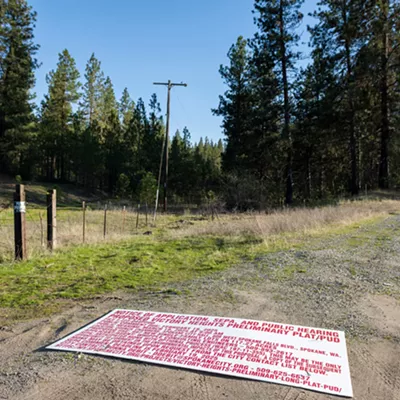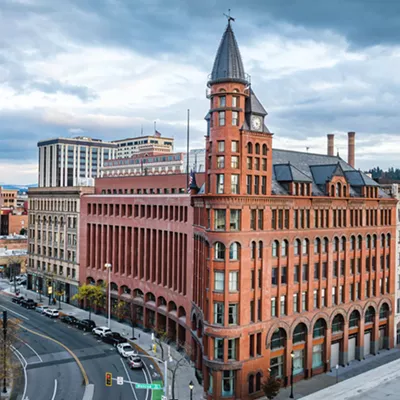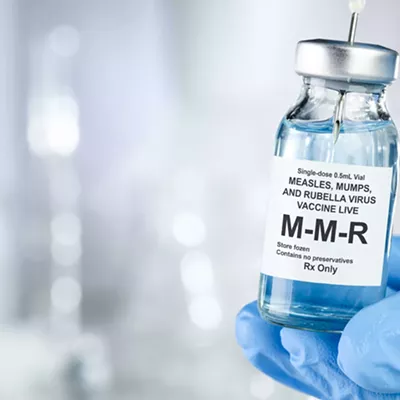Fall Arts Visual Arts - Chris Bruce
[
{
"name": "Broadstreet - Instory",
"component": "25846487",
"insertPoint": "4",
"requiredCountToDisplay": "4"
},{
"name": "Broadstreet - Empower Local",
"component": "27852456",
"insertPoint": "8",
"requiredCountToDisplay": "8"
},{
"name": "Broadstreet - Instory",
"component": "25846487",
"insertPoint": "12",
"requiredCountToDisplay": "12"
},{
"name": "Broadstreet - Instory - 728x90 / 970x250",
"component": "27852677",
"insertPoint": "18",
"requiredCountToDisplay": "18"
},{
"name": "Broadstreet - Instory",
"component": "25846487",
"insertPoint": "5th",
"startingPoint": "23",
"requiredCountToDisplay": "24",
"maxInsertions": 100
}
]
by Sheri Boggs
For six days in October, visitors to the WSU Museum of Art will find Andy Warhol's well-known "Athletes Series," as well as several of his trademark Campbell's soup cans. It's an exhibit that would be rare in the Inland Northwest, much less at a university museum in the heart of the Palouse. But if Chris Bruce, the museum's new director, has his way, it's the kind of high-caliber art exhibit local audiences will be seeing a lot more of.
"I contacted Richard Weisman, who is a friend of mine. Richard commissioned Andy to do this series of athletes who were popular at that time -- Mohammed Ali, Dorothy Hamill, O.J. Simpson, to name a few," says Bruce. "Richard was part of the whole Andy Warhol crowd at that time, and he went along on some of the photo shoots, so he's got all these great stories about each one of the prints."
The WSU Museum of Art will no doubt benefit from Bruce's many connections in the art world. After graduating from San Jose State University with his MFA, Bruce worked in several of Seattle's tonier galleries, including the Henry Gallery and the former Meyerson and Nowinski Gallery. When the opportunity to work at the still-in-development Experience Music Project came up, Bruce jumped at the chance in spite of the fact that he'd never done anything like it before.
"EMP was kind of an aberration in terms of what my professional life's always been about," says Bruce. "With EMP, I was charged with doing something so very different from what I'd done before. It was very high tech, very interactive. It was a challenge to take artifacts that were never designed to be displayed inside a glass case and finding new ways to display them as works of art."
Bruce hopes to accomplish a lot at the museum this first year, but most of what he wants to do falls under the umbrella of "improving the product we already have." Bruce hopes to bring the museum into a more strategic position by both increasing the number of visiting exhibits and capitalizing on artists and institutions already there.
"We're having a show of work from the Walla Walla Foundry next summer," he says. "This is an example of how we can focus on regional art without compromising. This is one of the great foundries in America, and not only is it local, it's an example of real excellence."
Along those lines, Bruce envisions the WSU Museum of Art as an institution for the study and discussion of Northwest arts, which includes not only the art itself, but also an emphasis on everything related to the visual arts, including private collectors, architects, designers and other related fields.
"We have a chance to distinguish ourselves as first and foremost a museum of Northwest art," he says. "Ultimately, that is what moves me, to move to this little town in Eastern Washington and see something here that, if we do it right, could really become something major."
Publication date: 09/11/03
For six days in October, visitors to the WSU Museum of Art will find Andy Warhol's well-known "Athletes Series," as well as several of his trademark Campbell's soup cans. It's an exhibit that would be rare in the Inland Northwest, much less at a university museum in the heart of the Palouse. But if Chris Bruce, the museum's new director, has his way, it's the kind of high-caliber art exhibit local audiences will be seeing a lot more of.
"I contacted Richard Weisman, who is a friend of mine. Richard commissioned Andy to do this series of athletes who were popular at that time -- Mohammed Ali, Dorothy Hamill, O.J. Simpson, to name a few," says Bruce. "Richard was part of the whole Andy Warhol crowd at that time, and he went along on some of the photo shoots, so he's got all these great stories about each one of the prints."
The WSU Museum of Art will no doubt benefit from Bruce's many connections in the art world. After graduating from San Jose State University with his MFA, Bruce worked in several of Seattle's tonier galleries, including the Henry Gallery and the former Meyerson and Nowinski Gallery. When the opportunity to work at the still-in-development Experience Music Project came up, Bruce jumped at the chance in spite of the fact that he'd never done anything like it before.
"EMP was kind of an aberration in terms of what my professional life's always been about," says Bruce. "With EMP, I was charged with doing something so very different from what I'd done before. It was very high tech, very interactive. It was a challenge to take artifacts that were never designed to be displayed inside a glass case and finding new ways to display them as works of art."
Bruce hopes to accomplish a lot at the museum this first year, but most of what he wants to do falls under the umbrella of "improving the product we already have." Bruce hopes to bring the museum into a more strategic position by both increasing the number of visiting exhibits and capitalizing on artists and institutions already there.
"We're having a show of work from the Walla Walla Foundry next summer," he says. "This is an example of how we can focus on regional art without compromising. This is one of the great foundries in America, and not only is it local, it's an example of real excellence."
Along those lines, Bruce envisions the WSU Museum of Art as an institution for the study and discussion of Northwest arts, which includes not only the art itself, but also an emphasis on everything related to the visual arts, including private collectors, architects, designers and other related fields.
"We have a chance to distinguish ourselves as first and foremost a museum of Northwest art," he says. "Ultimately, that is what moves me, to move to this little town in Eastern Washington and see something here that, if we do it right, could really become something major."
Publication date: 09/11/03
















